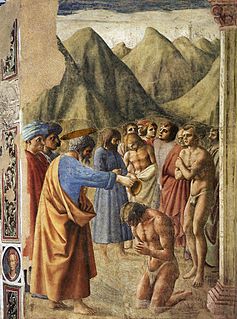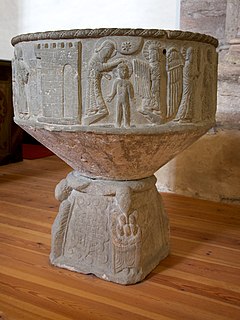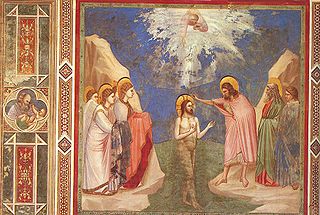
Baptism is a Christian rite of admission and adoption, almost invariably with the use of water, into Christianity. The synoptic gospels recount that John the Baptist baptised Jesus. Baptism is considered a sacrament in most churches, and as an ordinance in others. Baptism is also called christening, although some reserve the word "christening" for the baptism of infants. It has also given its name to the Baptist churches and denominations.
Born again, or to experience the new birth, is a phrase, particularly in evangelicalism, that refers to "spiritual rebirth", or a regeneration of the human spirit from the Holy Spirit, contrasted with physical birth.

Pentecostalism or Classical Pentecostalism is a renewal movement within Protestant Christianity that places special emphasis on a direct personal experience of God through baptism with the Holy Spirit. The term Pentecostal is derived from Pentecost, the Greek name for the Jewish Feast of Weeks. For Christians, this event commemorates the descent of the Holy Spirit upon the followers of Jesus Christ, as described in the second chapter of the Acts of the Apostles.

Infant baptism is the practice of baptising infants or young children. In theological discussions, the practice is sometimes referred to as paedobaptism, or pedobaptism, from the Greek pais meaning "child". This can be contrasted with what is called "believer's baptism", or credobaptism, from the Latin word credo meaning "I believe", which is the religious practice of baptising only individuals who personally confess faith in Jesus, therefore excluding underage children. Opposition to infant baptism is termed catabaptism. Infant baptism is also called "christening" by some faith traditions.

In Christian denominations that practice infant baptism, confirmation is seen as the sealing of Christianity created in baptism. Those being confirmed are known as confirmands. In some denominations, such as the Anglican Communion and Methodist Churches, confirmation bestows full membership in a local congregation upon the recipient. In others, such as the Roman Catholic Church, Confirmation "renders the bond with the Church more perfect", because, while a baptized person is already a member, "reception of the sacrament of Confirmation is necessary for the completion of baptismal grace".

A baptismal font is an article of church furniture used for baptism.

Andrea dal Monte Sansovino or Andrea Contucci del Monte San Savino was an Italian sculptor active during the High Renaissance. His pupils include Jacopo Sansovino.
Churches of Christ are autonomous Christian congregations associated with one another through distinct beliefs and practices. Represented chiefly in the United States and one of several branches to develop out of the American Restoration Movement, they claim biblical precedent for their doctrine and practice and trace their heritage back to the early Christian church as described in the New Testament.
The group of Christians known as the Christian Churches or Churches of Christ are congregations within the Restoration Movement, aka the Stone-Campbell Movement and the Reformation of the 19th Century, that have no formal denominational affiliation with other congregations, but still share many characteristics of belief and worship. Churches in this tradition are strongly congregationalist and have no formal denominational ties, and thus there is no proper name that is agreed to apply to the movement as a whole. Most congregations in this tradition include the words "Christian Church" or "Church of Christ" in their congregational name. Due to the lack of formal organization between congregations, there is a lack of official statistical data, but the 2016 Directory of the Ministry documents some 5000 congregations in the USA and Canada; some estimate the number to be over 6,000 since this directory is unofficial.

The Baptism of the Christ is the feast day commemorating the baptism of Jesus in the Jordan River by John the Baptist. Originally the baptism of Christ was celebrated on Epiphany, which commemorates the coming of the Magi, the baptism of Christ, and the wedding at Cana. Over time in the West, however, the celebration of the baptism of the Lord came to be commemorated as a distinct feast from Epiphany. It is celebrated in the Catholic Church as well as the Anglican and Lutheran Churches on the first Sunday following The Epiphany of Our Lord.

The Agony and the Ecstasy (1961) is a biographical novel of Michelangelo Buonarroti written by American author Irving Stone. Stone lived in Italy for years visiting many of the locations in Rome and Florence, worked in marble quarries, and apprenticed himself to a marble sculptor. A primary source for the novel is Michelangelo's correspondence, all 495 letters of which Stone had translated from Italian by Charles Speroni and published in 1962 as I, Michelangelo, Sculptor. Stone also collaborated with Canadian sculptor Stanley Lewis, who researched Michelangelo's carving technique and tools. The Italian government lauded Stone with several honorary awards for his cultural achievements highlighting Italian history.
The Indian Pentecostal Church of God (IPC) is the largest Pentecostal denomination in India.

Conversion to Christianity is a process of religious conversion in which a previously non-Christian person converts to Christianity. Converts to Christianity typically make a vow of repentance from past sins, accept Jesus as their Savior and vow to follow his teachings as found in the New Testament.
Baptism of Jesus or Christ may refer to:
Baptismal regeneration is the name given to doctrines held by major Christian denominations which maintain that salvation is intimately linked to the act of baptism, and that salvation is impossible apart from it. Etymologically, the term means "being born again" "through baptism" (baptismal). Etymology concerns the origins and root meanings of words, but these "continually change their meaning, … sometimes moving out of any recognisable contact with their origin … It is nowadays generally agreed that current usage determines meaning." While for Reformed theologian Louis Berkhof, "regeneration" and "new birth" are synonymous, Herbert Lockyer treats the two terms as different in meaning in one publication, but in another states that baptism signifies regeneration.

Believer's baptism is the Christian practice of baptism as this is understood by many evangelical denominations, particularly those that descend from the Anabaptist and English Baptist tradition. According to their understanding, a person is baptized on the basis of his or her profession of faith in Jesus Christ and as admission into a local community of faith.

The Battistero di San Giovanni is a religious building in Siena, Italy. It is located in the square with the same name, near the final spans of the choir of the city's cathedral.

The Penitent Magdalene is a wooden sculpture of Mary Magdalene by the Italian Renaissance sculptor Donatello, created around 1453–1455. The sculpture was probably commissioned for the Baptistery of Florence. The piece was received with astonishment for its unprecedented realism. It is now in the Museo dell'Opera del Duomo in Florence.

A sacrament is a Christian rite recognized as of particular importance and significance. There are various views on the existence and meaning of such rites. Many Christians consider the sacraments to be a visible symbol of the reality of God, as well as a means by which God enacts his grace. Many denominations, including the Catholic, Anglican, Lutheran, Methodist, and Reformed, hold to the definition of sacrament formulated by Augustine of Hippo: an outward sign of an inward grace that has been instituted by Jesus Christ. Sacraments signify God's grace in a way that is outwardly observable to the participant.
















